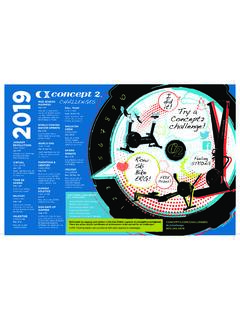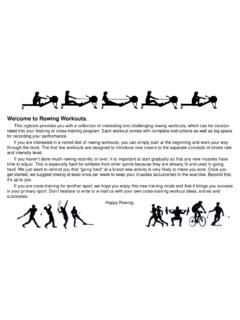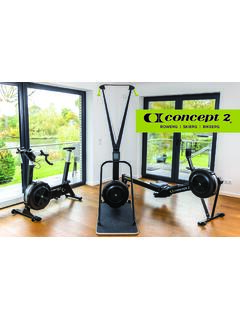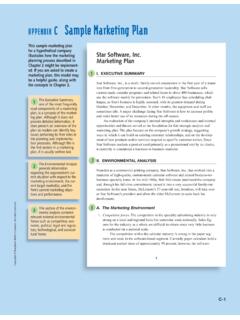Transcription of The Wolverine Plan - Concept2
1 The Wolverine plan Training plan of the University of Michigan Women s Rowing Team Prepared August, 2001; Tables Revised/Expanded June 2002 Introduction Training is distinct from "exercise" or "working out" in that the goal is to maximize performance in a particular sport or activity (as opposed to being active simply to promote good health, maintain acceptable body weight, etc. admirable goals, but below the expectations of the serious athlete). A Training plan , then, is a systematic and progressive program to allow an athlete to achieve her full potential in her chosen sport. What follows is a description of the Training plan used by the University of Michigan Women s Rowing Team. To understand how to get the most out of training, let us first review several core concepts exercise physiologists have identified as the Principles of Training, and consider their application to the sport of rowing.
2 Most important is the Overload Principle, which tells us an athlete must challenge herself to stimulate further physiological adaptation. An untrained person can stimulate significant physiological improvement by exercising at a modest intensity for 20-30 at a time 3-4 times per week. But the elite athlete needs to train more frequently, for longer durations, and at greater intensities. A second very important concept is the Specificity Principle. This means an athlete must perform the greatest portion of her training doing the actual activity in which she competes in this case, rowing. While occasional workouts doing cardiovascular activities such as running, biking, swimming, or stair climbing can supplement your basic training or provide a break from the monotony of rowing exclusively, we must recognize the limitations of cross-training.
3 (As a side note, we recognize that erging is only an approximation of rowing on the water, and can t develop many of the fine technical skills required for success. At the same time, as a training tool, in some ways erging is actually superior in that it allows us to much more accurately quantify performance, which is critical to success as will be discussed below.) Another application of the Specificity Principle is that a rower must train to perform during a 2000-meter race. Therefor the training for an event that lasts a little under seven minutes is different than for a 100m sprint or a marathon. A third Principle of Training is the Reversibility Principle. This means that training gains are not permanent. The outstanding performances of last year cannot be duplicated or improved without continued effort this year.
4 Athletes who stop training lose fitness, regardless of the reason (poor motivation, injury or illness, lack of time, etc.) How much and how fast varies depending on circumstances, but any reduction in training could make the crucial difference between winning and losing for the elite athlete. Finally, another Training Principle might be called the Individual Differences Principle. This recognizes that every athlete is genetically different and all athletes are not expected to respond to the same training program in the exact same way. Some athletes won t make the same progress over the course of the year as their teammates, and it won t be for lack of trying. However, the Training plan will allow every athlete her best chance at reaching her own personal potential. Your coaches consider the benefits of training so self-evident as to hardly require elaboration, so we ll confine ourselves to just a couple of comments relating training to success.
5 If the team s ultimate goal is to win the National Championship, then we must recognize this goal will not be achieved without cost. A favorite metaphor is to think of the NCAA finals as an auction, where each team and each crew will "bid" for their place. Training represents the funds you have available to make your bid. A crew that has trained poorly will be out-bid early, perhaps starting the race at a fast pace but fading quickly as their limited funds expire. A crew that has invested wisely in their Training plan and accumulated plenty of funds will be able to bid strongly early in the race, setting a fast pace in the first 600-700m while still having plenty of funds in reserve as the bidding increases in the middle of the race and into the final 200-300m. We want to show up at the line holding a sack of $100 bills in each hand, while our opponents are jingling a few coins in their change purse.
6 But to accumulate that amount of funds requires a substantial amount of training. (Perhaps during a lengthy ergometer workout, you can envision dollar signs where the meters appear, like a slot machine hitting a jackpot.) Still another metaphor is to imagine that when we race we are going to war, and superior training means we show up with bigger guns and more ammo. Before looking at our Training plan in detail, please consider a basic and unalterable truth: training is essential for success. This is a Law of Nature, like gravity. Your coaches have determined the amount of work necessary to give us a realistic chance to compete for a National Championship. This can t be negotiated. Still, athletes on occasion try. You can recognize how absurd the following conversation would be between a doctor and a very sick patient: Doctor: I m sorry to report you have cancer, which is life-threatening and will require painful and debilitating treatment for a long time.
7 Patient: But I have a husband and three young children and a part-time job, and I have so many plans right now! Doctor: Oh. In that case, you just have a bad cold. Yet some athletes apparently expect to have the following exchange with their coach: Coach: Here is the Training plan we need to follow to give us a chance to win NCAAs. It means several hard workouts a week from September to May with little mental or physical rest. Athlete: But I have to study and I have a boyfriend and I want to hang out with my friends and I tend to get sick easily! Coach: Oh. In that case, just train once in a while when you feel like it. The point is your coaches are only pointing out some physical truths, not setting policy for the Universe. If the goal is to win, the price can t be negotiated. The only thing that can be negotiated is the goal.
8 We could train less and still beat a lot of crews. The decision you the athlete must make is, how many crews am I satisfied with beating? General Features of the plan Before getting a complete description of the workouts we will do, there are some general features of the plan you should recognize. The first is, this is no magic formula and there are no clever gimmicks. Some will be disappointed to learn the secret to success is simply lots of hard work, which in the first place is no secret and in the second place anyone else can do too! The plan will help you organize and focus your efforts more efficiently, but athletes must accept that success or failure ultimately rests on your shoulders. Some find that a blessing and some a curse, but in one sense the plan is simply a way for you to take ownership of your readiness to race.
9 Another feature of the plan is that it doesn t vary much throughout the year. There are different levels of intensity for various workouts which range from short pieces at race pace and cadence to much longer pieces at lower ratings and power outputs. But all workouts will be performed throughout all portions of the year in roughly the same proportions (with the exception of a little less race-pace work in September and October). This is different from some approaches to training, which might label the fall as a time for laying an "aerobic foundation", the winter as a period for "general conditioning", and the spring as a time for "specific race preparation". In fact, effective training should always be geared toward specific race preparation. It is not possible to completely isolate and separate different aspects of physiology, training them separately and sequentially, expecting gains in one area to persist when moving on to another area.
10 This would be analogous to expecting an infant to grow by first maturing its skeleton, then its muscles, and then its vital organs. In fact, their growths are interdependent and each must mature in conjunction with the others. (Some tissues do mature at slightly different rates, but there must be a certain proportionality, and the same is true for training.) This plan is meant to apply equally to all workouts, whether performed on the ergometer or on the water. Once the basic formats and instructions are understood, each workout may be performed in either environment. This allows a lot of flexibility when water conditions are unrowable. And while it s nice to see athletes perform well on the erg, the ultimate goal is to perform well on the water. Towards this end, it is essential to perform the workouts consistently, with the same intensity for specific workouts when on the water as on the erg.












